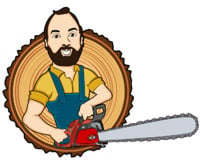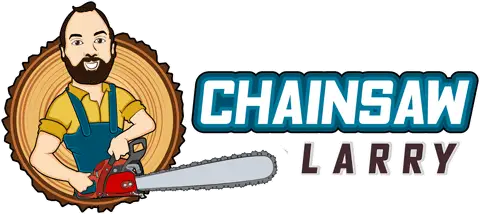Table of Contents
Are you trying to find out about the parts of a chainsaw?
If so, you’ll find everything you need here.
Below, is a list of the most important chainsaw parts and how each one works to power this tool.
Consider this the most complete guide of chainsaw terms and definitions.
Once you’re done looking at this guide, check out the top-rated chainsaws here. That page includes the top 10 chainsaws you can buy today.
I also have a post on the best budget chainsaw models for anyone who’s looking for a powerful tool at a cheap price.
The Parts of a Chainsaw
Note: The Occupational Safety and Health Administration (OSHA) requires that chainsaws have certain parts to meet a set of safety standards. Those parts are listed first and identified by an asterisk (*). Also, any chainsaw placed into service after February 9, 1995, must meet the requirements of ANSI B175.1-1991 (Gasoline-Powered Chainsaws Safety Requirements).
1. *Throttle
The throttle is what controls the speed of the chain. In a gas chainsaw, the throttle regulates the amount of fuel that reaches the combustion cylinders. More fuel = more speed. In an electric or battery chainsaw, the throttle controls the amount of amperage in the motor. More amperage = more power.
2. *Throttle Interlock
The throttle interlock prevents the throttle from accidentally being activated. The throttle interlock must be pressed before you can unlock and activate the throttle.
3. *Chain Catcher
The chain catcher is one of the most important safety parts of a chainsaw. The chain catcher is a special guard that’s designed to catch the chain if it breaks while spinning. This safety feature is essential for protecting the user from getting injured from a snapped chain.
4. *Chain Brake
The chain brake stops the chain from spinning when a sudden kickback occurs. Kickback can happen when the chain tip gets nicked or the chain gets pinched. Kickback is a fast upward thrust of the blade back toward the user and the chain brake prevents serious cutting injuries. A chain brake can be either manual (a handguard that gets pressed during the kickback) or inertia-activated (an automatic response based on force).
5. *Handguard
The handguard is a shield that protects the operator’s hands from flying debris while cutting. It also aids in protection against the top of the spinning chain.
6. *Anti-Vibration System
The anti-vibration system reduces the stress that’s put on the user’s hands while operating the chainsaw. The anti-vibration system absorbs the vibrations of the chainsaw’s engine which otherwise would cause stress on the hands, arms, and joints.
7. *Muffler
The muffler is an essential part of a gas chainsaw that reduces the noise level. Without the muffler, a gas-powered chainsaw would be too loud to operate or stand near without damaging your hearing.
If you’re in the market for this type of chainsaw, check out my dedicated guide on the best gas chainsaw for the money. It shows you how the find the perfect gas chainsaw for your needs, whether it be casual cutting, firewood splitting, or tree felling.
8. Chain
The chain is the part of a chainsaw that does the actual cutting. The chain includes sharp teeth that are at a set distance apart (pitch) and at a specific width (gauge). Each chainsaw uses a particular size chain. Not all chainsaw chains are universal.
9. Guide Bar
The guide bar is a metal bar the chain spins around. The guide bar holds the chain in place and keeps it straight while cutting.
10. Chain Tensioner
The chain tensioner controls the tension of the chain on the guide bar. If the chain is too tight, it won’t spin fast enough. If the chain is too loose, it can fall off while spinning. The chain tensioner helps you keep proper tension on the chain so the chainsaw cuts smoothly and safely.
11. Clutch
The clutch is attached to the chain sprocket. The clutch controls the spinning of the chain around the guide bar.
12. Flywheel
The flywheel controls the speed of the engine and helps to cool the motor down so it doesn’t overheat.
13. Decompression Valve
The decompression valve releases compression from the combustion chamber during the starting process in a gas chainsaw. The decompression valve makes it easier to start the chainsaw when pulling the starter rope.
14. Carburetor
The carburetor controls the fuel intake of the engine.
15. Air Filter
The air filter protects the engine from getting clogged with sawdust and dirt. A gas chainsaw requires a mixture of air and fuel to power the tool. This part filters the air so only clean air flows through the engine.
16. Choke Valve
The choke valve assists in the starting of the chainsaw. The choke valve controls the amount of air and fuel that reaches the carburetor.
17. Bucking Spikes
The bucking spikes help you dig the chainsaw into a log so you can perform straighter cuts. The bucking spikes also help to prevent a kickback while doing this type of cutting. Bucking spikes also go by the names, “bumper spikes”, and “dogs”.
Now You Know Your Chainsaw Parts
As you can see, chainsaws are full of complex parts to get the tool started, keep it running, and make it safe to operate.
While this is not an exhaustive list of every single part of a chainsaw, it does include the most important components every operator should be aware of. Getting into the finer details of each of the inner workings of the engines would require a full guide in and of itself.
As a reminder, I have several other guides for you to enjoy, including the top-rated chainsaws here that include the top 10 products for sale today, the best budget chainsaw models for anyone looking for a good deal, and the best gas chainsaw for the money.
I hope you enjoyed learning about the various parts of a chainsaw.
Happy sawing!

Your pal,
Chainsaw Larry

